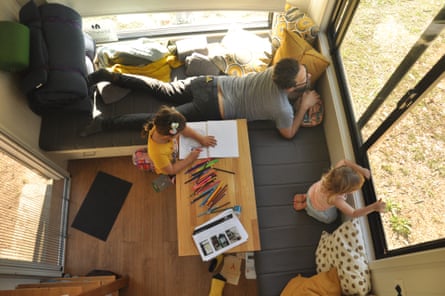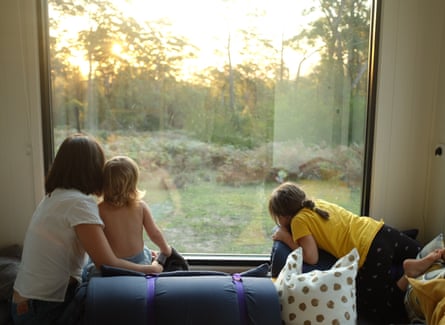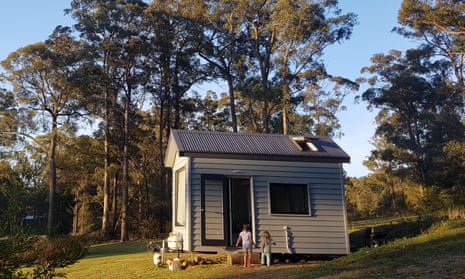“Oh,” I say as we pull into a clearing off a dirt track. “It’s really small.”
Which should not have come as a surprise, really – “it” being a tiny house and smallness being rather the point of it. But, as I checked my rear-view mirror to see my five-year-old unbuckled and silently trying to release her two-year-old sister from her car seat, I thought again: “That house is very small.”
“This would be so nice without kids,” my partner says, quietly.
The house sits dwarfed by eucalyptus trees on a rural property in Kangaroo Valley, two hours south of Sydney. Its large window, on the narrow front side, stares patiently west, waiting for the sunset over the small field of ferns which lay before more gumtrees and the escarpment on the horizon. There is nothing else and no one else within sight. It would be so nice without kids.
Cheers from the back seat and the unmistakable sound of a small person trying to override a child lock indicate the five-year-old had been successful. We let the children out of the car and they bolt towards the house with open arms, the toddler crying out: “My cubby house!”
Tiny houses have been around since the turn of the century, starting initially as a means of radical downsizing and rejection of burdensome traditional house ownership. Helped along by the #cabinporn movement, tiny houses have begun to crop up in the travel world; a grown-up, highly Instagrammable evolution of glamping, without the bunting and fairy lights.
This vision of a tiny house rarely involves more than two people. But In2TheWild, an Australian company with tiny houses scattered on semi-remote properties around the country, says you can fit four (two adult sized, and two small adults or children) in their 15 square metre off-grid eco-cabins. So here we are, a live experiment of a marketing hypothesis.

Four people fit in a tiny house thus: a small bathroom at the back flows off a kitchen with a fridge, sink and cupboards. Cushioned benches moonlight as beds for the small people and the double bed is in a loft. And therein, for the young traveller family, lies the challenge. As we endeavour to unpack our things (packing away being a critical component of sanity in a tiny house), like lemmings in reverse the children attempt to scale the ladder to the loft. My partner and I take turns to pry their tiny, chubby, vice-like hands from the fifth rung. Meanwhile, as if by some cosmic force, cards, books, pencils and colouring-in pads consume the table and all available floor space and someone tries to find a spot for all the shoes.
“Maybe we should go outside.”
The outside is expansive and there we do all the things one does in the bush: walk, play, try not to be killed by something venomous. Inside we eat, watch the day turn to a night filled with more stars than our city-dweller kids have ever seen. Kids asleep, with nowhere else to go, I climb the ladder to the loft. My partner passes up a bottle of shiraz and two glasses, and we drink it in near silence. This counts as serenity.
A shout of “Wake up!” pierces the morning sunrise with an enthusiasm and proximity that is impossible to ignore. There is a continuous jostling, clambering, near-ness, however it feels not claustrophobic but, frankly, nice as we lazily drink coffee and read books and have nowhere else to be. Plus we can reach the tissue box on the kitchen counter without leaving our chairs.
As the day marches on, we visit the river, build a campfire, run around, but we keep returning inside. The irony of having more space to ourselves was that we didn’t so much use it as watch it – drawn ever inwards to the tiny house, whether by novelty or the sheer force of comfort in the wild.

We stayed in the tiny house for two nights in total and, during that time, my partner, predominantly good-naturedly, swept the floor approximately infinity times. Even by tiny house standards, 15 sq metres is at the very, very small end of the spectrum.
For a holiday, and for those tiny house temperament inclined, tiny houses should not be ruled out. But they’re much like toasted marshmallows – great for holidays, however, if adopted as a centrepiece of daily life, they would quite likely lead to premature death.
Tiny houses are supposed to offer simplicity. The wild, a chance to breathe and freedom from being “on”. It would be amazing without children. But, as I watched my big girl read to my little girl, backlit by the Australian wilderness, I was reminded of a phrase from my wilder south-east Asian backpacker days: “Same, same – but different.”
Accomodation for this trip was provided by In2theWild. Midweek accomodation starts from $199 per night.
Looking for a holiday with a difference? Browse Guardian Holidays to see a range of fantastic trips

Comments (…)
Sign in or create your Guardian account to join the discussion